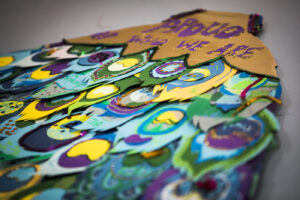Art
Art, craft and design embody some of the highest forms of human creativity. A high-quality art and design education should engage, inspire and challenge pupils, equipping them with the knowledge and skills to experiment, invent and create their own works of art, craft and design. As pupils progress, they should be able to think critically and develop a more rigorous understanding of art and design.

Art and Design
Intent
At Swanland Primary School, our children are artists and designers. Art, craft and design embody some of the highest forms of human creativity. Our high-quality art and design education should engage, inspire and challenge pupils, equipping them with the knowledge and skills to experiment, invent and create their own works of art, craft and design. We want them to have no limits to what their ambitions are and to aspire to be illustrators, graphic designers, fashion designers, curators, architects or printmakers. Our Art curriculum is designed to engage, inspire and challenge pupils, whilst equipping them with the knowledge and skills to be able to experiment, invent and create their own works of art. . As pupils progress, they should be able to think critically and develop a more rigorous understanding of art and design. They should also know how art and design both reflect and shape our history, and contribute to the culture, creativity and wealth of our nation.
We want to equip our children with the Art and Design National Curriculum but to prepare them for the opportunities, responsibilities and experiences of later life. We want our children to use the local area as inspiration, to learn from other cultures and to respect diversity. To that end, we have carefully selected a wide range of unique and diverse artists, craft makers and designers for children to study and have planned opportunities for children to visit the Art galleries and museums of our surrounding areas.
Implementation
The teaching and implementation of the Art and Design Curriculum at Swanland Primary School is based on the National Curriculum and progressive skills to ensure a well-structured approach to this creative subject.
Our Art Long Term plan ensures progression of skills and knowledge, breadth, consolidation, imagination and reflection. The work of famous local, national and international artists are explored to enhance the children’s learning. The children’s learning is further enhanced with art projects, artist in residence and art integrated into visits. Each child has a sketchbook. We give the child ownership of their sketchbook in order to foster their sense of creativity. Children use their sketchbooks to make initial sketches, develop skills, record ideas and develop opinions. Throughout the Swanland journey, every child is given the opportunity to learn the skills of drawing, painting, printing, sculpture and digital art through the exploration of key artists, craft maker or designer and their work. Through in-depth discussion, the pupils explore how their art can share commonalities with famous art and use subject-specific vocabulary to discuss key artworks and their own work. In the development of confident art critics, the pupils share their opinions and make informed observations about what will improve their own practical work. In KS1 and KS2, skills are planned to be revisited, giving the children the opportunity to extend their knowledge and practice in the context of a variety of artworks from a range of eras. Teachers follow a clear progression of skills which ensures all pupils are challenged in line with their year group expectations and are given the opportunity to build on their prior knowledge. Effective CPD and team meetings with Curriculum Lead are used to ensure high levels of confidence and knowledge are maintained. Early Years Foundation Stage Pupils explore and use a variety of media and materials through a combination of child initiated and adult directed activities.
Impact
Pupil Voice of Children at Swanland Primary school evidence that children enjoy, are motivated and feel skilled in the arts.
Summative assessments take place throughout the year and teachers record the progress and attainment against the National Curriculum expectations of attainment. Teachers use this information to inform future lessons; ensuring children are supported and challenged appropriately.
Further information is gathered through learning walks, pupil questionnaires; highlighting strengths and achievement and any improvements, knowledge and skills that still need to be embedded.
Children in Foundation Stage are assessed within Expressive Arts and Design and their progress is tracked termly using the Early Excellence tracker system. Age related expectation levels are reported to parents at the end of the reception year.
 Art learning is recorded in sketchbooks across the school. We encourage children to treat their sketchbooks like journals and their thoughts and learning are recorded in a format that they would like to use, for example, using thought bubbles. Each child is unique and each sketchbook should be unique, enabling children to develop their independence and creativity.
Art learning is recorded in sketchbooks across the school. We encourage children to treat their sketchbooks like journals and their thoughts and learning are recorded in a format that they would like to use, for example, using thought bubbles. Each child is unique and each sketchbook should be unique, enabling children to develop their independence and creativity.
Teachers assess children’s knowledge, understanding and skills in Art by making observations of the children working during lessons. Children are also encouraged to be critical of their own work, highlighting their own next steps.
In the Foundation Stage your child will be taught to use their imagination and explore materials.
The practitioner will provide a variety of materials and Foundation Stage resources to stimulate your child’s curiosity. Your child will explore and research, experiment and develop their own ideas.
Practitioners will introduce appropriate vocabulary to help your child to talk about what they have produced, what they like and how they can make it better. Topics covered include colours (mixing, expression); marks (shapes, lines, patterns); texture and media (smooth, rough, shiny; paint, chalk, crayon). Children also begin to learn about the ways in which paintings and drawings can capture feelings.
Ideas to develop art skills at home
Point out pictures, paintings, building designs, and objects such as furniture and ornaments to feed your child’s appreciation for how different sorts of art enrich our lives. Ask questions such as, ‘What colours and patterns have been used? What about the materials and textures – is it fabric or wood, smooth or rough? What do you like or dislike about it?’
Use similar questions to help your child talk about their own artwork . Give plenty of feedback and praise, and focus on those parts that are most detailed to build on their strengths.
A key skill at this stage is hand-eye coordination, so anything you can do that encourages your child to look first, then draw, and then look again will strengthen their art skills.
Explore different materials with your child and let them experiment with the different effects they can produce.
Try not to worry about it getting messy, most kids love tactile materials and enjoy interacting with them. Just make sure you put plenty of newspaper or an old sheet down!
In art lessons in KS1, your child will learn:
to use a range of materials creatively to design and make products
to use drawing, painting and sculpture to develop and share their ideas, experiences and imagination
to develop a wide range of art and design techniques in using colour, pattern, texture, line, shape, form and space
about the work of a range of artists, craft makers and designers, describing the differences and similarities between different practices and disciplines and making links to their own work.
Ideas to support art at home
Visit local art and craft events, such as exhibitions and workshops to build an early appreciation for paintings, ceramics, textiles and other art and design objects.
When looking at artefacts, buildings and designs, ask your child questions similar to those they’ll ask in class, such as “What do you like best about this?”, “Why do you think it’s this colour / has this particular feature?”, and “What is it made from?”
In KS2 art, children are taught:
to develop their techniques, including their control and their use of materials, with creativity, experimentation and an increasing awareness of different kinds of art, craft and design.
to create sketch books to record their observations and use them to review and revisit ideas.
to improve their mastery of art and design techniques, including drawing, painting and sculpture with a range of materials (for example, pencil, charcoal, paint, clay).
about great artists, architects and designers in history.
Ways to develop art skills at home
Look out for opportunities to visit museums, galleries and exhibitions to learn more about paintings, ceramics, textiles and other designed objects. Some also stage talks by artists and designers that offer a deeper understanding of their work.
Encourage your child’s critical awareness through questions like, “What is this work about?”, “Why was it made?”, “What visual and tactile elements are used?”
Chat with your child about how they are feeling, perhaps asking them, “How does it make you feel when X happens?” Write down the key emotion words they use. Present them with paints or sketching pencils and encourage them to draw a picture of their mood. Explain that it might be an abstract picture, where the meaning isn’t immediately obvious – look at some abstract art online together so that they understand they don’t have to represent emotion through objects.
They’re learning about… Communicating ideas and feelings through artwork.
1. Your child is unlikely to have a better excuse for looking at themselves in the mirror. A self portrait gives children the time to study their eyes, nose, mouth and the rest of their face and body, and to work out how it all fits together – perfect for teaching children how to draw basic body shapes.
2. Creating a self portrait allows the maximum amount of artistic freedom. It’s you, so you can create it anyway that you want. The simplicity of a self portrait means that children can experiment with whatever materials they like to create their portrait, and try any style they wish.
3. Self portraits are a great way to get into art history. Every artist, from Rembrandt to Tracey Emim, has had a go at their self portrait. It’s the perfect vehicle for tracing the changes in visual art from past to present.
4. Self portraiture is the most introspective of art forms. By creating a self portrait, children learn who they are, how they want to present themselves and what’s important to them.
5. Drawing a self portrait is also excellent for teaching children that these personal ideas aren’t the same as what everyone else thinks. Children can learn how diverse our society’s views, values and appearances are, and hopefully develop values of respect and tolerance.
6. Self portraiture helps your child to consider their aspirations for the future. When creating a self portrait it’s important to encourage your child not just to think about who they are but who they want to become.
7. Self portraits allow children to see how they change as they grow. Like everyone, children are changing all the time – both year to year and day to day. Regular self portraits allow children to document that change, and help them to understand it.
8. Finally, and perhaps most importantly, creating a self portrait is fun! Self portraiture should be about creating something for yourself, and not worrying about what other people think or how they may respond. Children will learn that doing art is, at its best, quick, simple and enjoyable.
https://youtu.be/tnIbpGsHXJk Full Cbeebies Pablo Live Lesson EXTRA | Primary Art and Design
